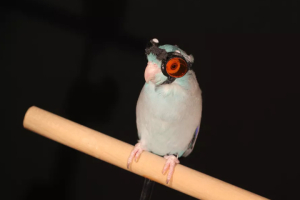The things that men and women over the ages have done in the name of love cannot be chronicled, ranging from the silly to the downright outrageous. However, the same can be said for science, too. Remember the legend of how Icarus came up with a pair of wax wings simply because he wanted to fly, but flew too near to the sun only to plunge to his death as his wax wings melted? I have always wondered whether he did not feel the heat of the sun in the first place on his skin which would surely have registered in his brain that it was getting way too hot -- and definitely before the melting point of wax, to turn back. Maybe he was using some really strong sunblock that remains undiscovered. But I digress -- here is a modern day Icarus, where a bird equipped with a pair of goggles flies through a laser sheet in the name of science. The reward for the bird? Some seeds at the other end of the room, but for science? We humans now know a wee bit more about the science of flight.
Fret not, this particular laser sheet has nothing to do with the one that you see in the Resident Evil series, where it will cut you into a gazillion pieces as said laser sheet goes right by you. This particular experiment was organized by Lentink Lab at Stanford University, where it was specially designed in order to pick up the nuances of flight so that we will be able to better understand how our avian friends take to the skies. Perhaps this kind of knowledge and discovery will be able to lead to more efficient flights for humans in the future where planes are designed, or even an ornithopter that can carry a human.
Basically, whenever a bird takes off, its wings will be able to generate small, circular currents of air that we call wingtip vortices. Such vortices’ movements were unable to be measured until now, where its results were published in the journal Bioinspiration & Biomimetics. This was made possible thanks to the laser sheet experiment, as researchers at Stanford University made use of a quartet of cameras in order to record a small parrotlet aptly named as Obi, who flew through said laser sheet. The wingtip vortices -- or really small tornadoes, were then able to be measured, and it was discovered that the way the air moves differed vastly from how we originally thought they did as theoretical calculations were used in the past. This would surely go some lengths in helping engineers and designers come up with better planes down the road.
Of course, it was not a smooth road to traverse in the first place. The bird had to be trained to fly through a wind tunnel, and the pair of goggles protected its eyes from the laser sheet as it flew through that. Thankfully, the primal urge for some seeds proved to be overwhelming and too strong, that it eventually made its way to the other end, and the high speed video managed to capture everything that the scientists and researchers required -- at least for now.

















